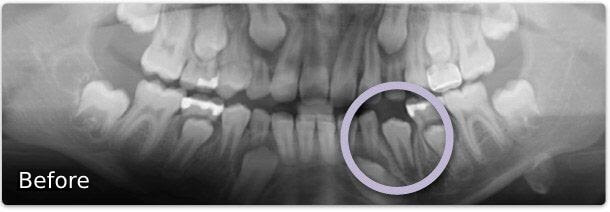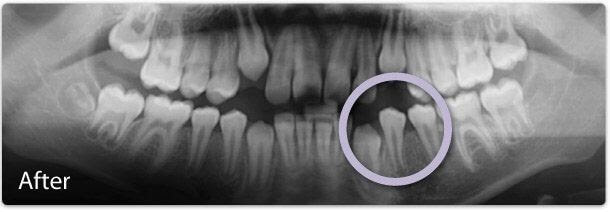Dickerson Orthodontics FAQ
Common questions about Invisalign, braces, pediatric dentistry, and general orthodontics. Can’t find your question? Give us a call at 480-963-2535 or email us using the button below.
General Questions
At what age should I schedule an appointment for my child?
Dr. Dickerson, Dr. Sharma, and the American Association of Orthodontists recommend children be seen by age 7. Early detection of many orthodontic problems can help avoid more extensive treatment later.
Do I need a referral from my dentist?
Nope! It is not necessary to have a referral from your dentist. Because orthodontists are looking for development issues rather than current problems, children should see an orthodontist around 7 years old, whether they have been referred or not. This also helps establish a baseline for the patient to compare future development of abnormalities. Teeth that are erupting in a normal fashion can suddenly go in different directions for no known reason, and orthodontists are trained to catch this teeth issue early.
How long will I be in treatment?
The length of treatment is different for each patient. Treatment times vary depending on the age of the patient, the complexity of the problem, and the patient’s cooperation.
Most of our patients finish orthodontic treatment in about a year. Sign up to get a free consultation today, and we will give you a customized treatment plan and clear expectation of how long your treatment will be – all at no cost to you.
What is Phase I (Early) Treatment?
The objective of Phase I Treatment is to develop appropriate jaw size. The most common reason for early treatment is to correct poor eruption problems with the teeth that may cause bigger problems if left for later treatment. By controlling the eruption of the permanent teeth, surgery will be avoided. No braces or other intervention would be done except for controlling where the permanent teeth would erupt.


Children sometimes exhibit early signs of jaw problems as they grow and develop. If children are found to have a jaw discrepancy by age 8, they are candidates for early orthodontic treatment.
The goal of Phase I Treatment is to develop the appropriate jaw size in order to accommodate all permanent teeth and to relate the upper and lower jaws to each other. This can be achieved by utilizing appliances that direct the growth relationship of the upper and lower jaws.
Will I need to have teeth extracted?
With the recent advances in technology, extracting teeth is not the normal course of treatment. Dr. Dickerson and Dr. Sharma are focused on how you will look in 30 years, not just when your appliances come off.
How often will I have appointments, and can I schedule all of my appointments after school?
It really depends on what is being done at each appointment. The time between appointments can range from a few days to 6 months. While in active treatment, the appointments are usually 2-3 months apart, saving you time away from school and work.
Since most of our patients are of school age, it isn’t always possible for us to see everyone after school hours. In consideration of your schedule, we will make every attempt to keep these appointments to a minimum.
What if I have an emergency?
Throughout your orthodontic treatment, emergencies are rare. If you are experiencing pain or something breaks, please call our office: 480-963-2535. In most cases, these issues can be resolved over the phone.
For a scratching wire, orthodontic wax can be placed over the wire, and a loose band or bracket can generally be left in place and repaired at your next visit.
Why should I choose an orthodontist instead of a general dentist for my orthodontic treatment?
Orthodontic treatment is very time-consuming and requires detailed treatment planning. An orthodontist has the extensive, specialized training and the additional two to three years of education necessary to provide patients with the best result. Orthodontics is all we do.
What is an orthodontist?
All orthodontists are dentists, but not all dentists are orthodontists. An orthodontist is a highly trained dental specialist who has completed two to three years of training after graduating from dental school and almost always only does orthodontics. An orthodontist not only straightens teeth but also is interested in the entire face, the bite, facial profile, and oral growth. In addition to giving people a beautiful smile, orthodontists also treat TMJ dysfunction, cleft lips and palates, craniofacial anomalies, and surgical orthodontic patients.
What is orthodontics?
Orthodontics is the movement of teeth. It is much more than just a teenage rite of passage, although approximately seventy percent of the U.S. population could benefit from orthodontic care. The goals and benefits of orthodontic treatment are the achievement of function, harmony, and balance between the teeth, jaws, and face for a lifetime of attractive, healthy smiles. Orthodontics can also relieve the unnecessary strain and discomfort that occur when teeth do not meet properly.
Do I have to see my family dentist too?
Continue to visit your family dentist, at least every six months, for a cleaning and examination during your orthodontic treatment. Good oral hygiene is not only important for your health, but it also helps your orthodontic treatment. If you are a person that accumulates plaque quickly, you may need 3 cleanings each year instead of 2. Clean, healthy teeth and gums allow teeth to move faster, speeding up treatment.
If any problems are detected between these visits, we will notify you and your family dentist so they may be taken care of as quickly as possible.
Braces FAQs
Complete Guide to Braces Cost >
Do braces hurt?
Modern braces are not like those in the past. Thanks to technology, today’s braces are smaller and more comfortable.
As a patient, you may experience some discomfort after certain visits. However, pain relievers such as Tylenol or Advil can help alleviate the pain.
How much do braces cost?
Each case is different, and no orthodontist can give a diagnosis over the phone. The length and type of treatment needed will determine the cost. When treatment is implemented at the appropriate time, it is often less costly than the dental care that may be needed to treat serious problems in the future.
Sign up today for a free consultation with us and we will walk you through a customized braces treatment plan and give you clear answers as to how much braces cost for you.
Will my child still need full braces if he or she has Phase I Treatment?
Dr. Dickerson and Dr. Sharma cannot determine if a patient will need full braces following Phase I Treatment until all of the permanent teeth have erupted. Each tooth has an exact location in the mouth where it is in harmony with the lips, cheeks, tongue, and other teeth. The objective of Phase I Treatment is to develop appropriate jaw size; in other words, it is orthopedic in nature, whereas the objective of Phase II Treatment is to achieve an ideal bite.
Is it too late to have braces if I am an adult?
More than ever before, adults are seeking orthodontic treatment. As long as you have healthy teeth and gums, you can have braces at any age.
Remember, it’s never too late to have straight teeth and a healthy smile; one-third of our patients are adults, and there is never a better time to improve your smile than today.
Can I still play my musical instrument with braces?
Yes, although there may be an initial period of adjustment.
Do I still see my family dentist while I have braces?
Yes. We recommend that all patients continue with routine visits to their general dentist every four to six months.
Invisalign FAQs
Complete Guide to Invisalign Cost >
What is Invisalign exactly?
Invisalign aligners are a series of custom-made clear plastic trays – imagine mouth-pieces. They move your teeth in small, pre-defined increments to achieve straight teeth and winning smiles. There are many different aligner brands, but Invisalign is the most advanced and well-known. Many people use ‘Invisalign’ interchangeably with clear aligners – sort of like Kleenex is used with tissues.
Invisalign aligners can be removed to eat or brush your teeth and are virtually invisible while you are wearing them.
Am I too old for Invisalign? Is my child too young?
You’re never too old to get your winning smile! As long as your teeth are healthy, Invisalign is a great option for you.
Children should wait until most of their permanent teeth have come in. Invisalign is very effective in helping to encourage healthy growth and development of jaws and dental arches.
Are Invisalign aligners painful?
Aligners do take a short time to get used to. Oftentimes patients report minor discomfort when starting a new aligner set. At Dickerson Orthodontics, the same technology we use to accelerate your tooth movement also helps to reduce the amount of discomfort you feel.
After a short adjustment period, many of our patients even forget they are wearing their Invisalign aligners.
Are there eating restrictions with Invisalign?
None! Aligners can be completely removed for meals, drinking wine, and sipping coffee – or other colored beverages. That means you can eat completely normally. No need to skip popcorn at the movies, ice in your drink, or wine with the ladies.
Can anyone use Invisalign®?
Drs. Dickerson and Sharma are Invisalign experts and can treat many cases with Invisalign that less experienced doctors cannot. Get a free consultation today and we will walk you through your particular case.
I want to be done as fast as possible. How do I do that?
Using OrthoPulse for 10 minutes each day will speed up your treatment and make you teeth more comfortable at the same time. This same technology is used by physicians to decrease pain and accelerate the healing process. OrthoPulse does this to safely move your teeth fast.
Retainer FAQs
Complete Guide to Retainers, Types of Retainers, and Benefits of Each >
What happens if I lose or break my retainer?
Call our office if you lose or break your retainer so that we may schedule an appointment to replace it as soon as possible. We’ll advise you of any repair or replacement fee(s) at that time. Remember, it’s important to protect the investment you’ve made in your healthy smile.
Do I have to wear my retainers all the time?
Wear both retainers as directed. If you have questions, feel free to call. Do not change how the retainers are worn without discussing it with the doctors first, as this may lead to movement of teeth and other complications. Although we see you less often now than when you wore braces, this retention phase is still extremely important! You’ll need to keep all office appointments to ensure that your treatment is completed successfully.
Will I be able to talk while wearing my retainer?
Your speech may be slightly affected the first week you wear your retainers, but don’t worry! All speech difficulties will diminish substantially after your mouth adjusts to them. The best way to speed up acclimation is to talk and practice.
How do I care for my retainers?
- Retainers should be cleaned after each meal (providing an excellent opportunity to brush your teeth).
- The best way to clean your retainer is with hand soap and a toothbrush or denture cleansing tablets.
- Your retainer is very sensitive to heat. Rinse it in lukewarm water only and never leave it in your hot car. Heat will distort your retainer.
- Never boil your retainer! To sterilize, soak it in mouthwash.
- Never wrap your retainer in a napkin while eating – they tend to be forgotten and eaten by the garbage can!
- Never put your retainer in your pocket – they’re often forgotten and broken.
- The best place to keep your retainer is in your mouth or in the retainer case provided for you.
- Don’t flip your retainer in your mouth with your tongue – it’s annoying to other people, can result in breakage, and will make your retainer loose.
- Keep your retainer out of small children’s and animals’ reach – children like to play with them and animals love to eat them.
Palatal Expander FAQs
What is a palatal expander?
An expansion appliance is a device used to widen the upper arch (roof of the mouth).
We use two types of expansion appliances: a rapid palatal expander, which is not removable, and an expansion retainer, which is. The kind of expander you use depends on your age and the amount of expansion necessary.
The amount and rate of expansion are different for every patient. Dr. Dickerson and Dr. Sharma will inform you of how many times you will need to widen the expansion screw. Following the active phase of expansion, the appliance should remain in place for a while longer, until new bone generates in the expanded arch.
Why do I need to wear a palatal expander?
Widening the mouth’s palate allows your upper and lower teeth to line up properly, giving you a better bite. Additionally, just as a high palate and a narrow arch restrict your breathing passages, widening the palate, in turn, widens the air passages, enabling you to breathe more easily through the nose.
The expanding action gently separates the elastic membrane in the center of the palate. Once the palate has been expanded fully, new bone tissue fills in the space. You’ll notice that widening the arches also temporarily causes a space between your two front teeth. Do not be alarmed. The space closes again naturally.
Will my palatal expander be uncomfortable?
Although your expander may cause some initial discomfort, such as a feeling of pressure, or a tingling under the appliance or at the bridge of the nose, these symptoms are temporary. Tylenol should effectively relieve your discomfort. If it does not, call our office so that we can check your appliance carefully.
How do I use my palatal expander?
We will provide you with explicit instructions regarding the activation of your palatal expander. You must regularly activate the appliance according to the schedule and the instructions given by our staff. Do not rush or delay the activation of the appliance.
How do I care for my palatal expander?
Clean the appliance carefully each time you brush your teeth. This and mouthwash will keep the appliance free of food and prevent irritation.
New Elastics FAQs
Will wearing elastics hurt?
There may be minor soreness initially from the elastics’ pressure. The more you wear them, the less discomfort you will experience. Some discomfort can be relieved by taking Tylenol according to the directions on the bottle.
What should I do if I lose my elastics or run out of them?
You may either stop by our office, and we will give you a new package, or you can contact our Chandler, AZ office at 480-963-2535 or by e-mail at info@smilemoreaz.com, and we will mail them to you.
What if I forget to wear my elastics?
Wearing elastics is like rolling a ball uphill. When the force is removed, the ball will roll back down the hill. Your teeth are positioned in the jaw by tiny elastic fibers. As your teeth move in the direction of the rubber bands, it stretches the fibers holding the teeth in their places. If the rubber band wear is stopped before the new bone has been generated to hold the teeth in their new positions, the teeth will move back to where they were, and we will have to start over. If you happen to forget to insert your elastics one day, do not double up the next day.
What should I do if I bend or break an elastic hook?
Call our Chandler, AZ office at 480-963-2535 immediately to schedule a repair appointment.
How often should I change my elastics?
Change your elastics every 12 hours so that they will not lose their pull. Remove the elastics only when you brush your teeth, and re-insert them when you are finished. As elastics get older, they lose their stretch and do not function as well. It’s very important to change them routinely, even if they are not broken.
How fast will my teeth move?
Teeth move approximately 1 mm per month with good elastic wear.
What if I don’t want to wear elastics?
There are several options other than wearing elastics. Wearing headgear, permanent metal coils, extractions, and jaw surgery are alternatives.
Where do I wear my elastics?
Watch and listen carefully to the instructions and demonstrations given by our staff or one the assistants. If you have any questions about proper insertion of your elastics, please call our Chandler, AZ office at 480-963-2535 or e-mail us at info@smilemoreaz.com.
Own Your Winning Smile
Get a Free Consultation
We believe it ought to be easy for you to get a smile you love – so we’ve made every part of the experience with us fast, simple, and clear. Starting with your initial consultation. Many places charge for an initial orthodontics consultation, but you deserve a winning smile. Book a free consult with us and we’ll help you understand your options, what it will cost, and what your smile can look like after Invisalign or braces.

